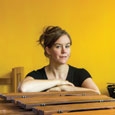Breaking a wrist is every musician’s worst nightmare. As a percussionist and conductor, I have avoided many activities that could result in a broken wrist for years. Volleyball? Basketball? Bungee jumping? No, thank you. Despite these precautions, I broke my right wrist last October, right before two solo recitals (percussion), a string festival (co-conductor), and our school production (director and conductor).
In the first few days, I struggled to accept what happened. I had to cancel an upcoming recital, which fortunately was postponed, and I had to postpone an important concert event, which ended up being canceled. I felt that event was pivotal for me; therefore, it was especially challenging to let it go. Nonetheless, what helped me in the first week was hearing stories from music colleagues and athletic directors that injuries can and do heal. One colleague told me his knee had actually become stronger, which led me to imagine all of the heightened technique awaiting me.
After indulging in self-pity for a few days, I distracted and redirected myself by making a list, which is how I solve most of my problems. Here is that list:
Finding Purpose with a Broken Wrist
• Practice left-handed
• Listen to music
• Notate score drafts
• Read Thai books
• Listen to spoken Thai
• Cuddle with family
• Lower body toning or aerobics
• Relax with a movie
• Practice mindfulness
• Read a book
The title of my list implied somehow that I felt my life might lack purpose with only one hand. In retrospect, I can laugh at myself a little for my dramatic thinking. However, for those of us whose identities are centered on being musicians, an injury can threaten that constructed self-identity.
Furthermore, it is important to know yourself, and I knew that much of my enjoyment and satisfaction came from the music-making routines that I had crafted. I knew that I would feel most vulnerable to depression about my wrist in the evenings, because that was when I normally composed or practiced music. I wanted to avoid a downward spiral during those hours, so I needed alternative ways to use that time.
I focused on behaviors that were either productive or that would leave me feeling positive. Some might have expected a list of ten musical items, and for many musicians, that would be a more beneficial list. Nonetheless, I found that there was only so much left-hand practicing I could do. After a day of working and teaching with a broken wrist, I was more exhausted than usual, and my left hand was already overused. I risked straining my left hand to the point of injury, so it helped to include options to relax.
Healing Is Paramount
The options that focused on music-making, including left-handed practice, listening to music and notating scores, were essential to my well-being. Breaking my wrist had left me with more time to listen to music and to read scores, which helped me both as a conductor and as a performer. Notating scores required too much left-hand use, and I needed to optimize my time to have any chance of rescheduling any performances. I decided that any energy left should be devoted to left-handed practice.
I postponed my October recital to January but accepted that my larger event was a missed opportunity that could not be rescheduled. To stay performance-ready for the recital, I dedicated time each night to visualization practice, ensuring that pieces would stay memorized. I also found a true silver lining in the experience when I identified two left-hand sections in my pieces that were weaker than I had realized. I was able to focus on them and bring subtlety and strength to their lines. The experience also highlighted that some of my practice strategies had become predictable and a shakeup was in order.
In early November, I was part of a group of string directors who gathered in Bangkok for a middle school string festival. Each director choose a piece for the massed string orchestra that we would also conduct. I had just broken my wrist a few days prior to the event and must have still been in shock, because it only occurred to me after the first rehearsal began that I had to figure out quickly how to conduct the piece with my left hand.
As I worked discreetly on this while waiting for my turn at the podium, one of the other directors sat next to me. We were meeting for the first time, so I asked him which school he came from and which piece was his. He replied that his piece had been canceled and that he was disappointed not to have the chance to conduct in the concert. I explained my own situation and asked him if he wanted to conduct my piece. He readily agreed. It was difficult to ask for help and give up the chance to conduct, but I am glad that I did. The young musicians needed a conductor with clear gestures, and their needs had to come before my ego.
Rehearsals leading up to the December production were challenging. Conducting with my left hand worked most of the time, but confused us all some of the time. As my cast and sling modulated to a wrist guard, I gradually shifted the baton to my right hand. Nonetheless, I had to be careful not to overdo it. My gestures had to stay small. Some days, I had to put the baton back into my left hand. As music directors we should be models of determination but also show a bit of common sense. I didn’t want to end up with even greater physical problems that would disrupt my music program, my students’ learning, and my own life. We are in this for the long game and it does not do ourselves or our students any favors by pushing through at all costs.
Getting through the Day
I am grateful that my sentence was short lived. I was in a cast for four weeks and wore a wrist guard for another four. During that time, I discovered that using a dictation program helped me immensely with emails and other written documents. I kept correspondences briefer than usual and delayed any writing or documentation that could wait. Unfortunately, at the time I was also taking an online course and evaluating teaching units. I informed the instructor and the senior reviewer that I would meet the deadlines, but that I would be starting the work a little later than normal. Because they were forewarned, people adapted their expectations.

Coming up with Good Stories
Answering “How did you break your hand?” multiple times a day left me in a perpetually foul mood. In those early days, I was trying to get through my day by ignoring the pain – more psychological than physical – and living in denial that I had broken my wrist. It was natural that colleagues and students were concerned and curious and unrealistic to wish away the reality. I transformed interactions for the better when I changed my response to their queries. Initially, my best response was the boring truth and my worst was an angry grunt and flight. I eventually chose to substitute these responses with more imaginative answers.
To students, I replied, poker-faced, “Skateboarding,” “Paragliding in Malaysia,” or “Snowboarding in Japan.” To faculty, I replied, “You should have seen the other guy” or “Rock climbing in Nepal.” It’s amazing how a bit of humor can ease a situation. Only some people are born with an immediate instinct to make light of what troubles them, but I am proof that this skill can be learned.
Takeaways
It was essential that I allow myself to feel grief and to sit with this discomfort for a few days. Other people may not need as much time; others may need more. I needed to spend some time with the discomfort to accept it and move forward. Moving forward was helped by hearing stories of healing from friends and colleagues and by creating a list of productive and positive alternative behaviors. This kept me hopeful, which in turn kept me from indulging in self pity.
I communicated directly, professionally, and humorously with concert organizers, course instructors, editors, colleagues, and students. I needed to acknowledge the deadlines that could still be met and find solutions for those that could not. I was grateful for empathy and understanding from my colleagues and students. We are responsible for our health. Resting, pacing, and keeping the bigger picture in mind were paramount to my own healing. I believe that for many, resting might be the most difficult strategy to implement because we have many responsibilities and high expectations for ourselves while not wanting to let others down.
I definitely gained some insights into myself, but I never suggest falling on your bathroom floor to achieve those insights (yes, that’s the horribly anti-climactic real story). I became more observant of how I used my practice time and also of my physical technique. I revisited a body awareness technique for alignment that I had used in the past and I found myself paying more attention to the balance between my hands. I also found that making additional time for score-reading and listening created a better balance towards developing my overall musicianship.
Much of my identity is interwoven with being a musician and I know that this is the case of many, if not most, musicians. The wrist break helped me reconnect with myself in different ways and on a different level. I was reminded that my identity stems from many facets: wife, mother, daughter, teacher, lover of the arts, and much more. Identity construction is beyond the scope of this article; however, we can always use a reminder that our value doesn’t come from our last best concert.
If none of what you have read resonates with you, perhaps a cliché will. This too shall pass. You will recover. You will play again.

.jpg)





